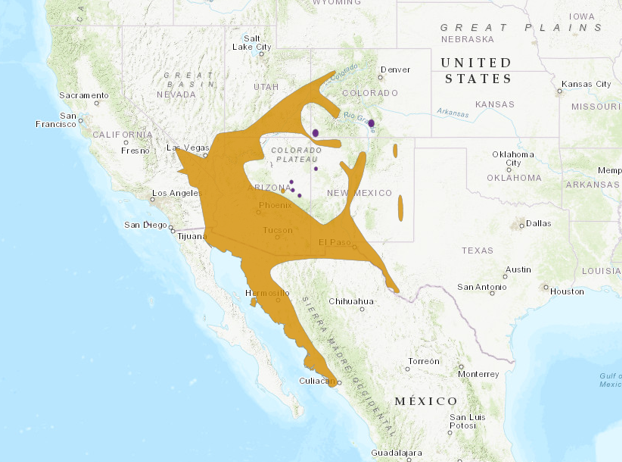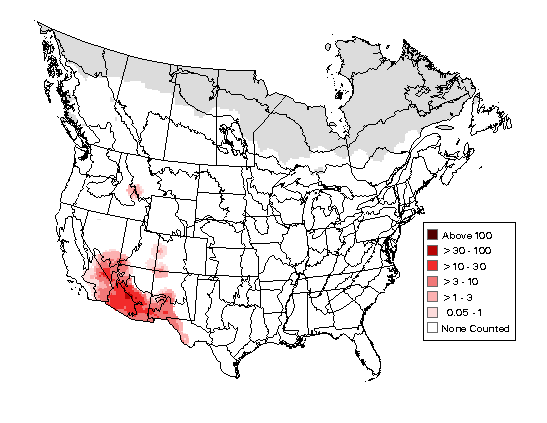Birdfinding.info ⇒ Common across much of its range, especially in Arizona, where it is among the most characteristic birds of the Sonoran Desert and can be found nearly throughout metropolitan Phoenix and Tucson. Outside of Arizona, sites where it is often seen include: Joshua Tree National Park and Salton Sea National Wildlife Refuge in California; Bosque del Apache National Wildlife Refuge in New Mexico; Franklin Mountains State Park in El Paso, Texas; Las Vegas, Nevada; and Grand Junction, Colorado. (See Breeding Bird Survey Abundance Map in Notes, below.) In Hawaii it is common only on Kaho’olawe, but is also seen occasionally on the Big Island along Saddle Road and rarely on Lanai.
Gambel’s Quail
Callipepla gambelii
Family: Odontophoridae
Deserts of the southwestern U.S. and northwestern Mexico, where it inhabits desert scrub and adjacent habitats including riparian woodland and urban parks.
Natural range spans most of the Sonoran Desert and adjacent arid lands, including portions of the Mojave, Chihuahuan, and Great Basin Deserts, from southern Nevada, central Utah, and western Colorado south to western Texas (to Big Bend National Park), central Chihuahua, and central Sinaloa.
Introduced populations are established in the Salmon River Valley of north-central Idaho, on San Clemente Island (west of San Diego, California), and on three of the main Hawaiian Islands: Lanai, Kaho’olawe, and the Big Island.
Identification
A plump gray-and-brown quail with a prominent topknot, very similar to its sibling species, the California Quail (see below).
The male is boldly patterned: chestnut crown and black face and throat bordered by crisp white lines.
The topknot consists of one or two black feathers jutting decoratively from the forehead like plumes on a fancy hat.
The belly is mostly cream-colored with a black central patch. The sides are mostly chestnut with white or cream-colored streaks.

Gambel’s Quail, male. (Sweetwater Wetlands, Arizona; November 13, 2017.) © Jim Merritt
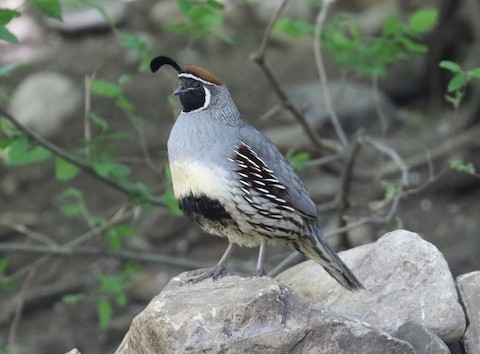
Gambel’s Quail, male. (East Whitetail Canyon, Hilltop, Arizona; April 19, 2018.) © Victor Stoll
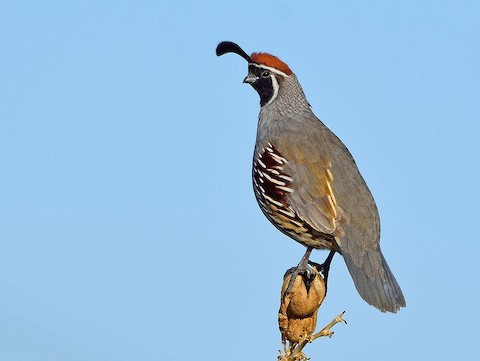
Gambel’s Quail, male. (Keystone Heritage Park, El Paso, Texas; October 13, 2019.) © Ad Konings
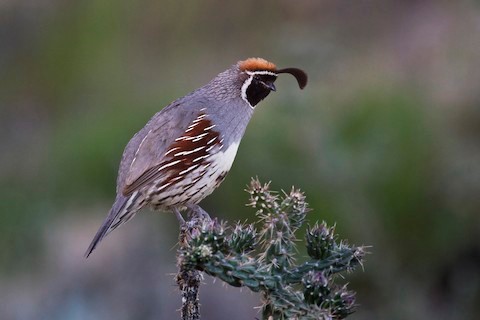
Gambel’s Quail, male with a whitish belly. (Embudito Canyon, Albuquerque, New Mexico; June 11, 2019.) © Liam Wolff

Gambel’s Quail, male with a yellowish belly. (Franklin Mountains State Park, El Paso, Texas; October 30, 2019.) © Ad Konings
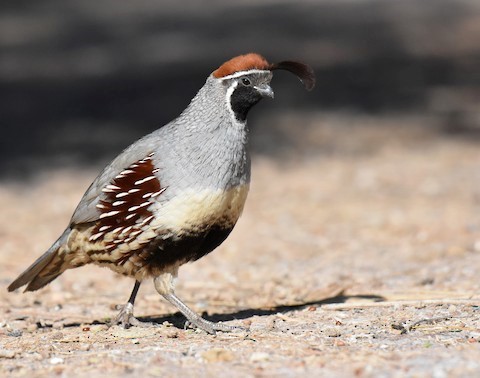
Gambel’s Quail, male. (Union Tract, Salton Sea National Wildlife Refuge, California; February 15, 2020.) © Jason Vassallo

Gambel’s Quail, male crowing. (Tellbrook Park, Las Cruces, New Mexico; May 15, 2019.) © Ad Konings
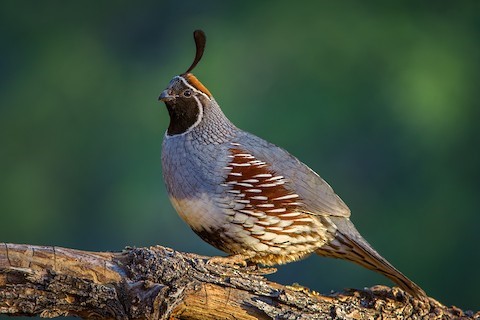
Gambel’s Quail, male. (Sedona, Arizona; April 26, 2017.) © Eric Gofreed
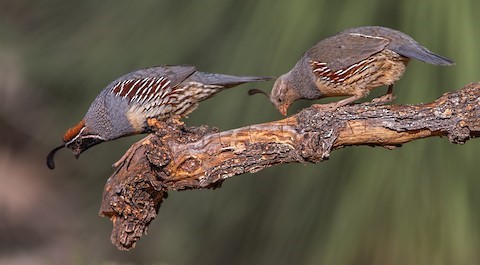
Gambel’s Quail, male and female. (Sedona, Arizona; April 26, 2017.) © Eric Gofreed
Female is similar to the male overall but much plainer, lacking the bold head pattern and black belly patch.
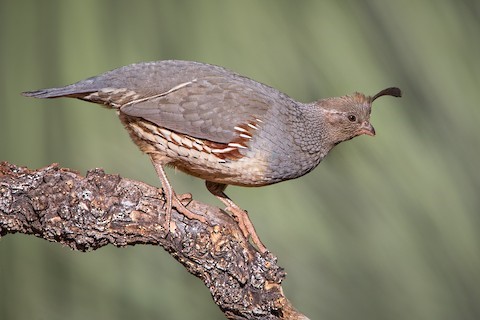
Gambel’s Quail, female. (Sedona, Arizona; April 26, 2017.) © Eric Gofreed
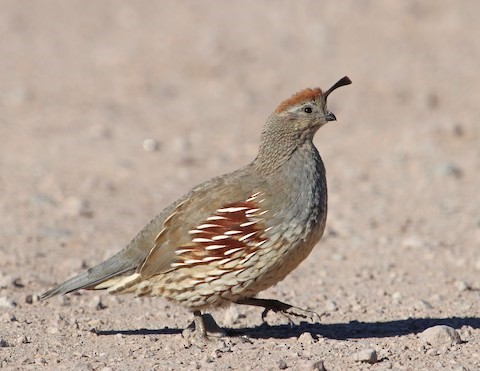
Gambel’s Quail, female. (Bosque del Apache National Wildlife Refuge, New Mexico; November 25, 2014.) © Jan Allen
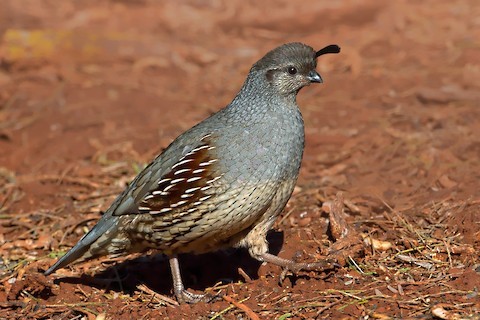
Gambel’s Quail, female. (Sedona, Arizona; December 28, 2016.) © Eric Gofreed
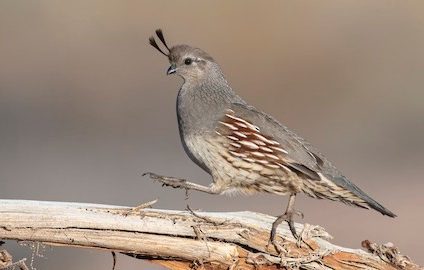
Gambel’s Quail, female. (Bosque del Apache National Wildlife Refuge, New Mexico; November 22, 2019.) © Bryan Calk
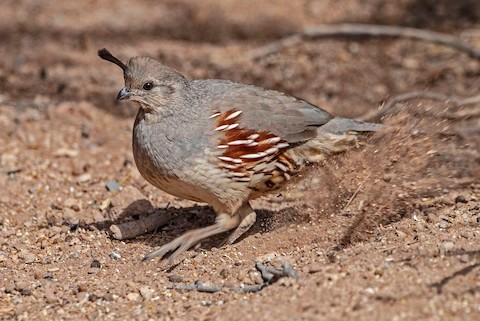
Gambel’s Quail, female. (Union Tract, Salton Sea National Wildlife Refuge, California; March 1, 2019.) © Andrew Simon
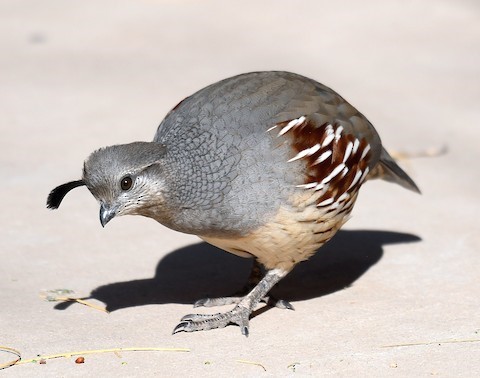
Gambel’s Quail, female—or perhaps more likely an immature male. (Union Tract, Salton Sea National Wildlife Refuge, California; November 1, 2019.) © Dan Murphy
Cf. California Quail. California and Gambel’s Quails are closely related and bear an obvious resemblance. Their ranges overlap marginally from Utah to Baja California, and in these areas they have been known to interbreed. Males differ conspicuously in their belly patterns: mostly solid patches of whitish or yellowish and black on Gambel’s versus heavy scaling on California.
The females resemble one another more because their coloration is muted and female Gambel’s typically shows a textured pattern on the belly—not as clearly scaled as female California, but it can be similar. A consistent feature of Gambel’s is the chestnut coloration on the sides, which California lacks.
Notes
Polytypic species consisting of seven recognized subspecies.
References
Alderfer, J., and J.L. Dunn. 2014. National Geographic Complete Birds of North America (Second Edition). National Geographic Society, Washington, D.C.
BirdLife International. 2018. Callipepla gambelii. The IUCN Red List of Threatened Species 2018: e.T22679609A131906681. https://dx.doi.org/10.2305/IUCN.UK.2018-2.RLTS.T22679609A131906681.en. (Accessed August 25, 2020.)
eBird. 2020. eBird: An online database of bird distribution and abundance. Cornell Lab of Ornithology, Ithaca, N.Y. http://www.ebird.org. (Accessed August 25, 2020.)
Howell, S.N.G., and S. Webb. 1995. A Guide to the Birds of Mexico and Northern Central America. Oxford University Press.
Madge, S., and P.J.K. McGowan. 2002. Pheasants, Partridges, and Grouse: A Guide to the Pheasants, Partridges, Quails, Grouse, Guineafowl, Buttonquails, and Sandgrouse of the World. Princeton University Press, Princeton, N.J.
Pyle, R.L., and P. Pyle. 2017. The Birds of the Hawaiian Islands: Occurrence, History, Distribution, and Status. Version 2 (January 1, 2017). http://hbs.bishopmuseum.org/birds/rlp-monograph/. B.P. Bishop Museum, Honolulu, Hawaii.
Sibley, D.A. 2000. The Sibley Guide to Birds. Alfred A. Knopf. New York.
Xeno-Canto. 2020. Gambel’s Quail – Callipepla gambelii. https://www.xeno-canto.org/species/Callipepla-gambelii. (Accessed August 25, 2020.)

